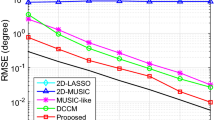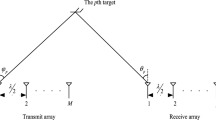Abstract
The mutual coupling, gain-phase error and sensor position error of the transmit and receive arrays would significantly degrade the performance of high-resolution direction of departure and direction of arrival estimation algorithms. By applying two well-calibrated instrumental sensors in both transmit and receive arrays, a novel angle estimation and self-calibration method, which considers the combined influences of the above three array errors, is proposed for bistatic MIMO radar. We show that the integrated array errors can be translated to angularly dependent gain-phase error. Then, a reduced dimensional method is used to estimate the angles and the angularly dependent gain-phase error coefficients. Based on the estimated angularly dependent gain-phase error coefficients, the nonlinear least squares optimization model for the three array errors are established and a quasi-Newton optimization method is applied to estimate the mutual coupling matrix, gain-phase error and sensors position errors of the transmit and receive arrays, respectively. Our simulation results corroborate our analysis.








Similar content being viewed by others
References
M.L. Bencheikh, Y.D. Wang, H.Y. He, Polynomial root finding technique for joint DOA DOD estimation in bistatic MIMO radar. Signal Process. 90, 2723–2730 (2010)
B.L. Chen, The Theory and Method for of Optimization (Tsinghua University Press, Beijing, 2005)
D.F. Chen, B.X. Chen, G.D. Qin, Angle estimation using ESPRIT in MIMO radar. Electron. Lett. 44, 770–771 (2008)
J.L. Chen, H. Gu, W.M. Su, Angle estimation using ESPRIT without pairing in MIMO radar. Electron. Lett. 44, 1422–1423 (2008)
B. Friedlander, A.J. Weiss, Direction finding in the presence of mutual coupling. IEEE Trans. Antennas Propag. 39, 273–284 (1991)
E. Fishler, A.M. Haimovich, R.S. Blum, L.J. Cimini, D. Chizhik, R.A. Valenzuela, MIMO radar: an idea whose time has come, in Proceedings of IEEE Radar Conference, (Philadelphia, PA, USA, 2004), pp. 71–78
E. Fishler, A.M. Haimovich, R.S. Blum, L.J. Cimini, D. Chizhik, R.A. Valenzuela, Spatial diversity in radars-models and detection performance. IEEE Trans. Signal Process. 54, 823–838 (2006)
A.A. Gorji, R. Tharmarasa, T. Kirubarajan, Optimal antenna allocation in MIMO radars with collocated antennas. IEEE Trans. Aerosp. Electron. Syst. 50, 542–558 (2014)
Y.D. Guo, Y.S. Zhang, N.N. Tong, ESPRIT-like angle estimation for bistatic MIMO radar with gain and phase uncertainties. Electron. Lett. 47, 996–997 (2011)
A.M. Haimovich, R.S. Blum, L.J. Cimini, MIMO radar with widely separated antennas. IEEE Signal Process. Mag. 25, 116–129 (2008)
A. Hassanien, S.A. Vorobyov, Phased-MIMO radar: a tradeoff between phased-array and MIMO radars. IEEE Trans. Signal Process. 58, 3137–3151 (2010)
H.B. Li, Q. Wei, J. Jiang, H.L. Tian, Angle estimation and self-calibration for bistatic MIMO radar with mutual coupling of transmitting and receiving arrays, in Proceedings of 2014 IEEE Workshop on Electronics, Computer and Applications, (2014), pp. 354–357
J. Li, P. Stoica, MIMO Radar Signal Processing (Wiley, New York, NY, 2009)
J.F. Li, X.F. Zhang, R.Z. Cao, Reduced-dimension MUSIC for angle and array gain-phase error estimation in bistatic MIMO radar. IEEE Commun. Lett. 17, 443–446 (2013)
J.F. Li, X.F. Zhang, X. Gao, A joint scheme for angle and array gain-phase error estimation in bistatic MIMO radar. IEEE Geosci. Remote Sens. Lett. 10, 1478–1482 (2013)
J. Li, M. Jin, Y. Zheng, Transmit and receive array gain-phase error estimation in bistatic MIMO radar. IEEE Antennas Wirel. Propag. Lett. 14, 32–35 (2015)
X.L. Liu, G.S. Liao, Direction finding and mutual coupling estimation for bistatic MIMO radar. Signal Process. 92, 517–522 (2012)
B.H. Wang, Y.L. Wang, H. Chen, Y. Guo, Array calibration of angularly dependent gain and phase uncertainty with carry-on instrumental sensors. Sci. China Ser. F Inf. 47, 777–792 (2004)
T.Q. Xia, Joint diagonalization based DOD and DOA estimation for bistatic MIMO radar. Signal Process. 108, 159–166 (2015)
X.F. Zhang, L.Y. Xu, L. Xu, Direction of departure (DOD) and direction of arrival (DOA) estimation in MIMO radar with reduced-dimensional MUSIC. IEEE Commun. Lett. 14, 1161–1163 (2010)
X.F. Zhang, D.Z. Xu, Angle estimation in bistatic MIMO radar using improved reduced dimension Capon algorithm. J. Syst. Eng. Electron. 24, 84–89 (2013)
G.M. Zheng, B.X. Chen, M.Y. Yang, Unitary ESPRIT algorithm for bistatic MIMO radar. Electron. Lett. 48, 179–181 (2012)
Z.D. Zheng, J.Y. Zhang, Y.B. Wu, Multi-target localization for bistatic MIMO radar in the presence of unknown mutual coupling. J. Syst. Eng. Electron. 23, 708–714 (2012)
Z.D. Zheng, J. Zhang, J.Y. Zhang, Joint DOD and DOA estimation of bistatic MIMO radar in the presence of unknown mutual coupling. Signal Process. 92, 198–203 (2012)
Acknowledgments
This work was supported by the National Natural Science Foundation of China under Grants 61501501, 61372166. The authors are grateful to anonymous reviewers for their valuable comments and suggestions which have greatly improved this paper.
Author information
Authors and Affiliations
Corresponding author
Appendix
Appendix
First of all, let
and
Since the derivative of the projection matrix \(\varvec{P}_{\varvec{\varTheta }}^\bot \) with respect to \({\varvec{\zeta }}_r^{\left( k \right) } \) is [2]
by substituting (36) into (35), we have
For




where \(\delta _{m,n} = {\left\{ {{\begin{array}{ll} 1, &{} m=n \\ 0, &{} m\ne n \\ \end{array} }}\right. }.\)
By substituting (47)–(49) into (46), and after some manipulations, the gradient vector \(\varvec{V}_r \left( {{\varvec{\zeta }}_r^{\left( k \right) } } \right) \) of (24) can be solved.
Rights and permissions
About this article
Cite this article
Guo, Y., Zhang, Y., Tong, N. et al. Angle Estimation and Self-calibration Method for Bistatic MIMO Radar with Transmit and Receive Array Errors. Circuits Syst Signal Process 36, 1514–1534 (2017). https://doi.org/10.1007/s00034-016-0365-9
Received:
Revised:
Accepted:
Published:
Issue Date:
DOI: https://doi.org/10.1007/s00034-016-0365-9




